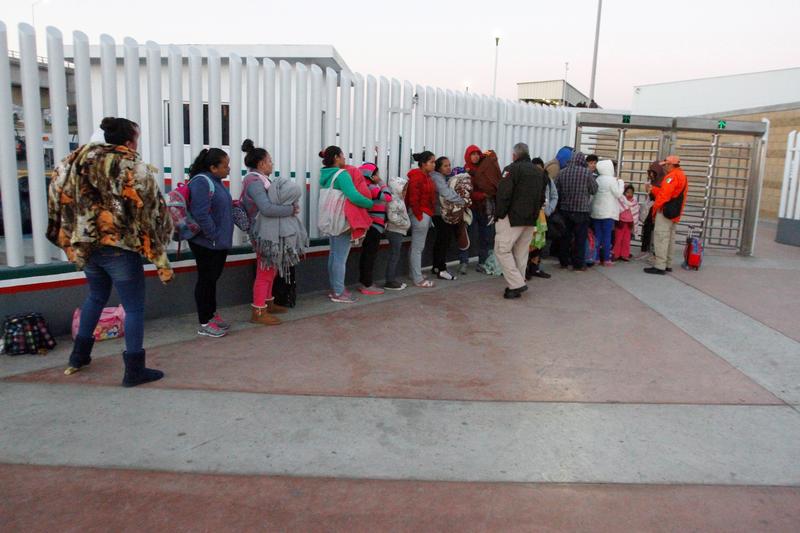
The lines of people at various ports of entry along the U.S.-Mexico border did not form by chance. It is a deliberate policy of Donald Trump’s administration to lengthen the wait for those that apply for asylum so that they remain for the longest possible time in Mexican territory.
That is what is shown by a study undertaken by three academic institutions — the Robert Strauss Center of the University of Texas at Austin, the Center for U.S.-Mexican Studies of the University of California, San Diego, which I have led since September 2017, and the Migration Policy Centre of the European University Institute.
The report released this week analyzes and compares how the asylum process works at eight ports of entry that share a border with the cities of Tijuana, Mexicali, Nogales, Ciudad Juárez, Piedras Negras, Nuevo Laredo, Reynosa and Matamoros.
The Immigration and Nationality Act of our neighboring country was inspired by two international conventions, one in 1951 and the other in 1967, on the status of refugees. The underlying principle is that of “no return,” that is, protecting people from being sent back to a country that puts their lives, physical integrity and freedom in danger.
Yet the Trump administration is pushing that principle by employing two interrelated practices. The first, which is known in English as “metering,” assigns numbers to the asylum applicants so that they wait in queue in Mexico. Second, the policy of “zero tolerance,” brought forward by former Attorney General Jeff Sessions, criminalizes those that enter the United States by any other means than through a port of entry. That is, the person who enters the United States without immigration documents is considered a criminal and cannot request asylum. (This executive order has been blocked by a federal district judge.)
The study demonstrates that the Department of Homeland Security is institutionalizing this practice all along the border with Mexico: “There is currently no processing capacity” for all of those that are seeking asylum. Day after day, the Mexican government is told how many applicants can be seen, and only these applicants can go to the border facilities in the United States. The result is that the de facto responsibility of organizing the waiting line falls on Mexico.
Supposedly, one can request asylum at any port or gate of entry. But in practice it does not operate that way. For example, in Tijuana, there are three ports or bridges that connect with San Diego. Yet asylum seekers are only processed at the newest of the points of entry, El Chaparral.
The counting, or metering, began in 2016 when Haitians arrived. Since there were so many – more than 10,000 in Tijuana – they organized themselves, writing down their names in a notebook. The practice of writing names down continued, and now the migrants that are waiting their turn manage the process; at night the notebook is protected by Grupo Beta, the arm of the National Migration Institute charged with seeing that migrants are not abused.
I spoke with two of the migrants who are among those that manage the notebook in Tijuana. One is from Nicaragua, the other from the Mexican state of Michoacán. I have omitted their names to protect their security. The man has come with his child, a student that was repressed and threatened with death by members of Daniel Ortega’s paramilitary. The woman came because they caused her husband to disappear in Apatzingán, Michoacán, and threatened the lives of her daughters.
Both became organizers because they are natural leaders and want to make a small contribution to improving thing at an inhospitable border. Often they have to make important decisions – for example, what to do with a woman who has lost her place in line because she has given birth.
According to the study, in Piedras Negras, Coahuila, there is a different dynamic. Faced with the same old song from the United States, “there isn’t capacity to process them,” a considerable number of Cubans and Africans spend the night on the border bridges themselves. When the residents complained, the mayor took action. He moved them to city shelters and organized a waiting list.
The study concludes that at the United States ports of entry, the assignment of the number of people that will be processed every day (metering) has been standardized. Yet in Mexico, there is no protocol. The organization of the waiting line takes different forms in different border cities. That demonstrates that the Mexican Secretariat of the Interior has not intervened in the matter, nor has it developed a clear policy on how to proceed given the directives regarding asylum from the Trump administration.
It also notes that these practices, which are confusing and offer little transparency, affect precisely those who are in states of extreme vulnerability: the applicants for asylum, who are already tired, spent and far from home.
We are very good at calling out Trump’s outbursts and anti-immigrant measures, but on the issues of migrants in transit and the day-to-day operation of the asylum process in the United States, we have been, at least, reactive, with little coordination.

Leave a Reply
You must be logged in to post a comment.